Soviet and Russian Space History - Pictures
The difficulty of getting reliable information for many years gave
the Soviet space program a special interest to many of us in the
West, an interest which hasn't waned as accurate information has
become available on the scope and details of their programs. I show
here a few pictures (click to enlarge) from Moscow and travelling
exhibits of Soviet
space hardware, followed by some material from Russian books
on these topics.
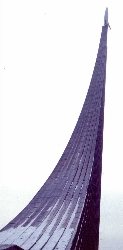
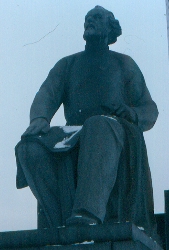 Museum
of Cosmonautics, Moscow: These shots are from
a December 1990 trip, the same one that involved working with the
6-meter
telescope of the USSR Academy of Sciences. On this visit,
I learned that my boots were bigger than the sizes of the shoe protectors
the guides passed around to protect the floor, and managed to talk my way
back into the main hall for solo pictures by convincing them I
was using very sensitive film. The building is topped by a soaring
100-meter pylon, of steel with titanium facing,
calling up visions of Tsiolkovsky, appropriately represented next to
the pylon..
Museum
of Cosmonautics, Moscow: These shots are from
a December 1990 trip, the same one that involved working with the
6-meter
telescope of the USSR Academy of Sciences. On this visit,
I learned that my boots were bigger than the sizes of the shoe protectors
the guides passed around to protect the floor, and managed to talk my way
back into the main hall for solo pictures by convincing them I
was using very sensitive film. The building is topped by a soaring
100-meter pylon, of steel with titanium facing,
calling up visions of Tsiolkovsky, appropriately represented next to
the pylon..
At the base of each side of the huge pylon is a frieze symbolizing
the human reach into the heavens. One can make out various kinds of
workers, a tracking antenna, a soldier, scientists, and some huge
figure that I would swear is Mother Russia (or some personification of
the Rodina) if this weren't otherwise such an example of socialist
realism. These pictures were taken in December 1990, accounting for the
snowy rims highlighting some of the figures.
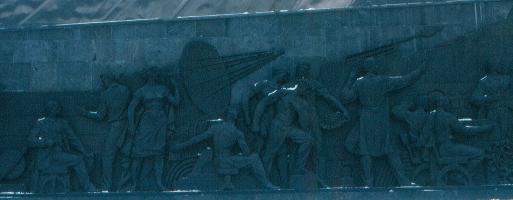
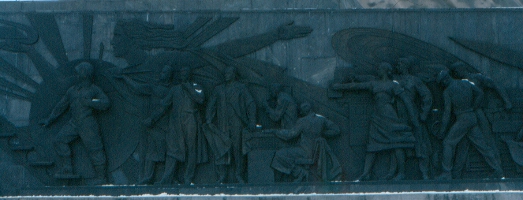
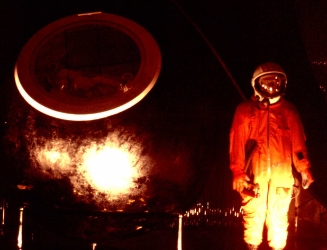 A prominent
item on display is this duplicate of Gagarin's capsule Vostok 1
and what may be his suit. As best I could tell, the guides described
this as his actual capsule, which other information places at RKK
Energiya these days. Gagarin's spacecraft now may be like pieces
of the True Cross in mediaeval Europe - all the boosters in the
inventory wouldn't be enough to carry them all.
A prominent
item on display is this duplicate of Gagarin's capsule Vostok 1
and what may be his suit. As best I could tell, the guides described
this as his actual capsule, which other information places at RKK
Energiya these days. Gagarin's spacecraft now may be like pieces
of the True Cross in mediaeval Europe - all the boosters in the
inventory wouldn't be enough to carry them all.
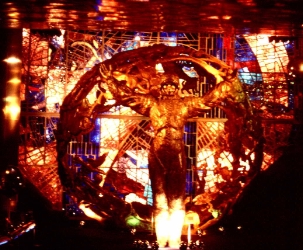 The most striking thing I found about the layout of the museum
was this amazing display of a cosmonaut figure against a stained-glass
background, gently illuminating one end of the main exhibit hall.
Tell me the officially atheist society didn't encourage a view of
cosmonaut-as-savior! Cruciform figure, gentle colored light,
respectfully dark and quiet surroundings... this fits with some
of the more abstract Soviet and later Russian space art, such as
appeared in In the Stream of Stars.
The most striking thing I found about the layout of the museum
was this amazing display of a cosmonaut figure against a stained-glass
background, gently illuminating one end of the main exhibit hall.
Tell me the officially atheist society didn't encourage a view of
cosmonaut-as-savior! Cruciform figure, gentle colored light,
respectfully dark and quiet surroundings... this fits with some
of the more abstract Soviet and later Russian space art, such as
appeared in In the Stream of Stars.
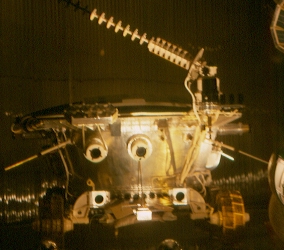 This mockup shows an
especially interesting piece of Soviet exploration technology,
a Lunokhod ground-controlled lunar rovers. Two of these wandered
about the Moon: one launched on Luna 17 in 1970, landing in Mare Imbrium,
and the second launched on
Luna 21 in 1973 (arriving in the crater Le Monnier). The turtle-shell opening
top, along with radioisotope heating, provided an elegant solution
to thermal control during the extreme temperature cycles of lunar day
and night. This view from the front shows two of the six wire-mesh
wheels, helical antenna on top, and stereo TV cameras. In searching for
more information, one finds both spellings Lunakhod and Lunokhod in
English-language publications; the closer transliteration is Lunokhod.
This mockup shows an
especially interesting piece of Soviet exploration technology,
a Lunokhod ground-controlled lunar rovers. Two of these wandered
about the Moon: one launched on Luna 17 in 1970, landing in Mare Imbrium,
and the second launched on
Luna 21 in 1973 (arriving in the crater Le Monnier). The turtle-shell opening
top, along with radioisotope heating, provided an elegant solution
to thermal control during the extreme temperature cycles of lunar day
and night. This view from the front shows two of the six wire-mesh
wheels, helical antenna on top, and stereo TV cameras. In searching for
more information, one finds both spellings Lunakhod and Lunokhod in
English-language publications; the closer transliteration is Lunokhod.
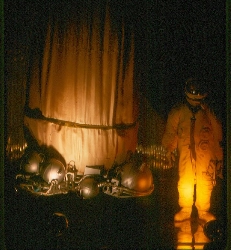 A signal achievement of the early cosmonaut program was Alexei
Leonov's first "spacewalk" (EVA). This mockup shows how they
used an inflatable airlock to allow depressurization around him
on leaving the cramped Voskhod 2 capsule. The display also shows
the "Berkut" space suit design produced for this mission. (Berkut,
Golden Eagle, has been a very popular name for Russian aerospace
projects right down to the present).
A signal achievement of the early cosmonaut program was Alexei
Leonov's first "spacewalk" (EVA). This mockup shows how they
used an inflatable airlock to allow depressurization around him
on leaving the cramped Voskhod 2 capsule. The display also shows
the "Berkut" space suit design produced for this mission. (Berkut,
Golden Eagle, has been a very popular name for Russian aerospace
projects right down to the present).
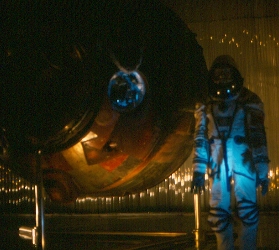 The descent module of Soyuz 37, along with the emergency and
rescue suit worn by Oleg Makarov. This view shows the bell-shaped
reentry capsule tipped toward the viewer, with the heat shield
hidden from view and one of the circular windows offering a
slight view of the illuminated interior. Soyuz 37 (of the Soyuz
7K-T variety) was used for a crew-exchange and Intercosmos
mission to Salyut 6 in 1980, most notable for carrying Vietnamese
crew member Pham Tuan.
The descent module of Soyuz 37, along with the emergency and
rescue suit worn by Oleg Makarov. This view shows the bell-shaped
reentry capsule tipped toward the viewer, with the heat shield
hidden from view and one of the circular windows offering a
slight view of the illuminated interior. Soyuz 37 (of the Soyuz
7K-T variety) was used for a crew-exchange and Intercosmos
mission to Salyut 6 in 1980, most notable for carrying Vietnamese
crew member Pham Tuan.
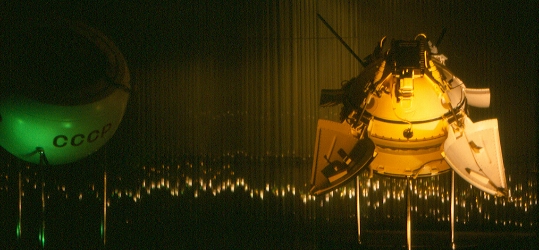 The Soviet interplanetary program is represented by these
mockups of the landing probes Mars 3 (left) and Venera 4.
Mars 3 reached the surface and apparently returned telemetry
for a few seconds (but, alas, no recognizable imagery), well
before the Viking landings of 1976. Venera
4 was more successful (part of the highly successful Venus program
of the USSR), returning measurements from the hostile
Cytherean surface.
The Soviet interplanetary program is represented by these
mockups of the landing probes Mars 3 (left) and Venera 4.
Mars 3 reached the surface and apparently returned telemetry
for a few seconds (but, alas, no recognizable imagery), well
before the Viking landings of 1976. Venera
4 was more successful (part of the highly successful Venus program
of the USSR), returning measurements from the hostile
Cytherean surface.
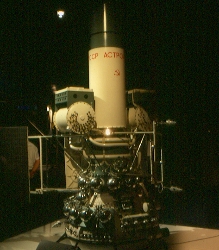 The French-Soviet Astron satellite for ultraviolet astronomy,
launched in 1983 into high Earth orbit (period about 96 hours,
apogee near 175,000 km). This vehicle was based
around the design of the Venera spacecraft. The centerpiece was
a 0.8-meter telescope, roughly contemporary with similar in scope to
the
International Ultraviolet Explorer but, due apparently to detector
limitations, never really able to
use its larger aperture to scientific advantage.
Some of its results from the literature include observations of
Supernova 1987A in parallel with IUE and Hubble, chromospheric emission
from flares on red-dwarf stars, molecular
lines from Comet Halley, and the UV spectra of normal galaxies.
Astron also carried an independent X-ray spectrometer, and operated
for more than five years. It would be 1990 before UV-capable
telescopes of larger aperture were orbited (specifically, both
Hubble and the Hopkins Ultraviolet Telescope on Astro-1).
This picture was
taken at an Interkosmos travelling exhibit, at the Dutch amusement
park "De Efteling" near Kaatsheuvel in the southern part of the
Netherlands, in July 1986.
The French-Soviet Astron satellite for ultraviolet astronomy,
launched in 1983 into high Earth orbit (period about 96 hours,
apogee near 175,000 km). This vehicle was based
around the design of the Venera spacecraft. The centerpiece was
a 0.8-meter telescope, roughly contemporary with similar in scope to
the
International Ultraviolet Explorer but, due apparently to detector
limitations, never really able to
use its larger aperture to scientific advantage.
Some of its results from the literature include observations of
Supernova 1987A in parallel with IUE and Hubble, chromospheric emission
from flares on red-dwarf stars, molecular
lines from Comet Halley, and the UV spectra of normal galaxies.
Astron also carried an independent X-ray spectrometer, and operated
for more than five years. It would be 1990 before UV-capable
telescopes of larger aperture were orbited (specifically, both
Hubble and the Hopkins Ultraviolet Telescope on Astro-1).
This picture was
taken at an Interkosmos travelling exhibit, at the Dutch amusement
park "De Efteling" near Kaatsheuvel in the southern part of the
Netherlands, in July 1986.
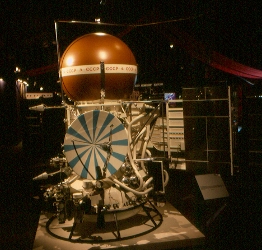 In another
picture from the July 1986 Interkosmos exhibit in the Netherlands,
this is a mockup of one of the Vega (Venera-Gallei or Venus-Halley)
probes, then recently having completed successful comet flyby missions.
Along the way, during Venus gravitational slingshots, each left a
probe carrying a balloon into the upper atmosphere of Venus, to be
tracked by a global network of Earth-based radio telescopes to add
wind velocity to the in-situ data they returned. In addition
to the images of the comet nuclei returned by the Vega probes, they
participated in the "Pathfinder" project, in which they were closely
tracked by multiple antenna locations on Earth, allowing detailed
triangulation of the comet's position and path based on their images,
which then allowed the Giotto probe to be target more precisely for
its daringly close flyby of the nucleus.
In another
picture from the July 1986 Interkosmos exhibit in the Netherlands,
this is a mockup of one of the Vega (Venera-Gallei or Venus-Halley)
probes, then recently having completed successful comet flyby missions.
Along the way, during Venus gravitational slingshots, each left a
probe carrying a balloon into the upper atmosphere of Venus, to be
tracked by a global network of Earth-based radio telescopes to add
wind velocity to the in-situ data they returned. In addition
to the images of the comet nuclei returned by the Vega probes, they
participated in the "Pathfinder" project, in which they were closely
tracked by multiple antenna locations on Earth, allowing detailed
triangulation of the comet's position and path based on their images,
which then allowed the Giotto probe to be target more precisely for
its daringly close flyby of the nucleus.
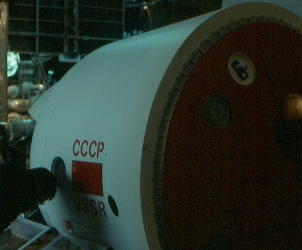 Moving now to a travelling exhibit seen at the US Space and Rocket
Center in Huntsville, in January 1991, the first item is a mockup
of a fresh Soyuz re-entry module - note the crisp white paint.
On the heat shield you can see the covers for (what I take to be) two
of the small retrorockets used to slow the final landing for
Soyuz capsules - watch for the puff of exhaust and dust just before
landing on some of the video. The CCCP logo wasn't in use very long
after that exhibition came around.
Moving now to a travelling exhibit seen at the US Space and Rocket
Center in Huntsville, in January 1991, the first item is a mockup
of a fresh Soyuz re-entry module - note the crisp white paint.
On the heat shield you can see the covers for (what I take to be) two
of the small retrorockets used to slow the final landing for
Soyuz capsules - watch for the puff of exhaust and dust just before
landing on some of the video. The CCCP logo wasn't in use very long
after that exhibition came around.
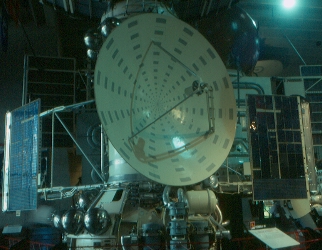
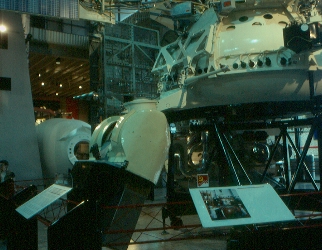 Here's a Vega again, now with a good view of the dish
antenna and solar arrays. As an astronomer, I would key in on the
scan platform holding the imaging instruments (right) used for the
closeups of the nucleus of Comet Halley... Note the dark glare
shields extending downward, and the robust construction designed
to handle the hostile environment of the comet's coma (hence the
housing around the moving parts).
Here's a Vega again, now with a good view of the dish
antenna and solar arrays. As an astronomer, I would key in on the
scan platform holding the imaging instruments (right) used for the
closeups of the nucleus of Comet Halley... Note the dark glare
shields extending downward, and the robust construction designed
to handle the hostile environment of the comet's coma (hence the
housing around the moving parts).
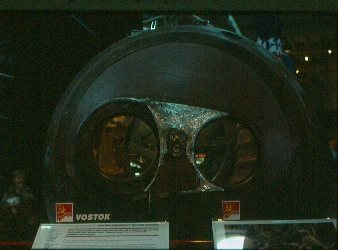 For space
history, it's hard to beat the Vostok, the absolutely
original human spacecraft. This is listed as an actual
returned Vostok capsule (flight unspecified). One opening
looks right to be the porthole window, but the second one
seems to be new for inspection of the interior.
For space
history, it's hard to beat the Vostok, the absolutely
original human spacecraft. This is listed as an actual
returned Vostok capsule (flight unspecified). One opening
looks right to be the porthole window, but the second one
seems to be new for inspection of the interior.
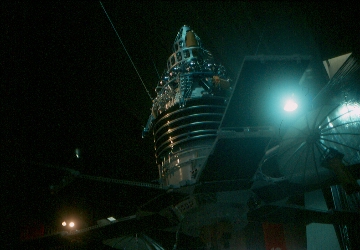 A mockup
of one of the Molniya communications satellites, a mainstay of
Soviet systems for decades. Since a significant part of the USSR/Russia
lies too far north to get a good line of sight to satellites
in geosynchronous orbits (above the equator), they settled on what
have since been known as Molniya orbits - highly elliptical and
inclined orbits that spend most of their time at high altitudes
above northern latitudes. So high, in fact, that students at the
University of Arizona were able to watch the Moscow evening news
by pointing an antenna across the North Pole. Several Soviet and Hungarian
stamps featured Molniyas, readily identifiable by the six radial
solar arrays. Free hint - remember to accent the first syllable, or
Russians will laugh at you and have great trouble telling what
you're talking about.
A mockup
of one of the Molniya communications satellites, a mainstay of
Soviet systems for decades. Since a significant part of the USSR/Russia
lies too far north to get a good line of sight to satellites
in geosynchronous orbits (above the equator), they settled on what
have since been known as Molniya orbits - highly elliptical and
inclined orbits that spend most of their time at high altitudes
above northern latitudes. So high, in fact, that students at the
University of Arizona were able to watch the Moscow evening news
by pointing an antenna across the North Pole. Several Soviet and Hungarian
stamps featured Molniyas, readily identifiable by the six radial
solar arrays. Free hint - remember to accent the first syllable, or
Russians will laugh at you and have great trouble telling what
you're talking about.
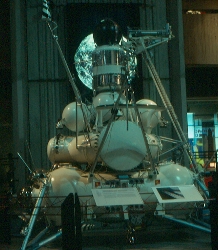 Finally, from the
Huntsville exhibit, a mockup of one of the automated Luna
landers. This configuration shows one of the sample-return
missions, which used a clever bit of celestial mechanics to
simplify the trajectory. There are regions near the eastern
(Mare Crisium) limb of the lunar nearside, from which a
trajectory which starts vertically in a specified velocity'
range will reach the Earth (within the return capsule's thermal
limits on velocity and entry angle). This mockup shows the
conveyor to bring the surface sample to the dark return
capsule, sitting atop its own rocket for lunar launch.
Luna missions returned samples from Mare Crisium, the
highlands near Apollonius, and Mare Fecunditatis (all of
which are close together near the dynamical sweet spot for
straightforward direct return).
Finally, from the
Huntsville exhibit, a mockup of one of the automated Luna
landers. This configuration shows one of the sample-return
missions, which used a clever bit of celestial mechanics to
simplify the trajectory. There are regions near the eastern
(Mare Crisium) limb of the lunar nearside, from which a
trajectory which starts vertically in a specified velocity'
range will reach the Earth (within the return capsule's thermal
limits on velocity and entry angle). This mockup shows the
conveyor to bring the surface sample to the dark return
capsule, sitting atop its own rocket for lunar launch.
Luna missions returned samples from Mare Crisium, the
highlands near Apollonius, and Mare Fecunditatis (all of
which are close together near the dynamical sweet spot for
straightforward direct return).
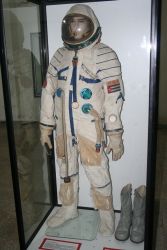 Some artifacts from the
Interkosmos flight of Arnaldo Tamayo Mendez, Soyuz 38, are on
display in the Museo del Aire in Havana. From an academic
exchange visit in May 2007, here are some pictures of
the suit used by the backup Cuban cosmonaut (left), and some
of the in-flight experimental gear:
Tamayo Mendez' orange rescue suit
Audiovisual stimulation experiment and
Cortex-2M nervous-system experiment
Filters from Hatuey bacteriology experiment
Azucar crystal-growth apparatus
Some artifacts from the
Interkosmos flight of Arnaldo Tamayo Mendez, Soyuz 38, are on
display in the Museo del Aire in Havana. From an academic
exchange visit in May 2007, here are some pictures of
the suit used by the backup Cuban cosmonaut (left), and some
of the in-flight experimental gear:
Tamayo Mendez' orange rescue suit
Audiovisual stimulation experiment and
Cortex-2M nervous-system experiment
Filters from Hatuey bacteriology experiment
Azucar crystal-growth apparatus
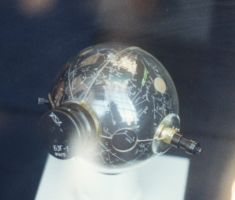 This small celestial
globe was carried as a navigational aid on a Soyuz/Salyut mission. The
cosmonauts found it so useful that they brought it home. I'd probably
recall which mission it was if the NASM still had this piece on
display, but it is either off display or was on loan when I saw it...
(details welcome!) Orion is just visible to the upper left.
This small celestial
globe was carried as a navigational aid on a Soyuz/Salyut mission. The
cosmonauts found it so useful that they brought it home. I'd probably
recall which mission it was if the NASM still had this piece on
display, but it is either off display or was on loan when I saw it...
(details welcome!) Orion is just visible to the upper left.
Some relevant links:
Memorial Museum of Cosmonautics
NSSDC pages on
Lunakhod 1 and
2
TV images from Lunakhod 1
and 2
Soviet and Russian Space History - Book Summaries
Courtesy of a Ukrainian grad student, I have a copy of the two-volume
Bitva za Zvezdy - Kosmicheskoe Protivostoyanie, or "Battle for the
Stars - Standoff in Space (I'd go with the simpler "Space Race" as a
dynamic equivalent). This is a history by Anton Pervushin, which
emphasizes the roads not taken. I worked on my astronautics vocabulary
(that wasn't common to astrophysics), and reproduce here a lengthy summary
(which also got posted to the FPSPACE list). The volumes appeared in
2003, from Izdatelsvto AST, Moscow
(part of their military history
series). Volume 1 deals with rocket systems in the pre-space age (B.G.
or Before Gagarin), while volume 2 continues up to the present and future
prospects. More stuff by Pervushin is available as
part of
Sergei Khlynin's site.
I'll note a few things from various chapters that struck me as newish,
in some cases apparently not in astronautix.com yet. The chapter numbering
is continuous.
Vol 1: Raketnye Sistemy Dokosmicheskoi Ery
(Rocket systems before the space age)
subtitle page Cosmonautics in the pre-space age
Introduction - he comes clean on his particular interest in the projects
that never made it to metal, illustrating the point by way of a bit of
alternative history:
USSR orbits "Sputnik" in 1957. World press yawns, seeing it as simply a
response to US Orbiter of 1956. Cognoscenti note that it is much larger,
carries biological specimens. Korolev follows with actual Sputnik 1
and openly discussed these plans beforehand. It is clearly a prototype
spaceplane with space for a pilot. Eisenhower counsels caution, sets meetings
and lays out a decade plan, trying to restrain public opinion. Lyndon
Johnson pushes for a faster program, including Dyna-Soar. Lavochkin
announces a booster, Pobeda - based on an ICBM - which can launch
a winged spacecraft fromanywhere on Earth. Vladimir Ilyushin becomes the
first man in orbit in 1959, in the 5-ton Krasnaya Zvezda spacecraft.
Overshoots landing site by 1000 km. Eisenhower publicly announces
commitement to Dyna-Soar. Meanwhile Ilyushin's world tour causes a global
sensation. Six more Vostok booster flights follow in 1959-60. One cosmonaut
is lost on re-entry; a second, Sergei Shiborin, dies when retrofire
fails and his spacecraft remains in orbit.
USSR showers European press with information and plans, wielding great
political influence. Nixon elected in 1960; the space race isn't a major
campaign issue. USSR announces a new kind
of armed force, tactical space forces as well as nuclear-armed satellites
in high orbit. As a show of force, 15 such military spaceplanes are
launched, maneuvering to make clear the potential of targeting New York.
Penkovski provides details on the system, executed for treason.
US administration panics. Nixon personally pushes Dyna-Soar.
1961 - Cuban fiasco as contras are repulsed. USSR seriously damages
carrier Enterprise with conventional space-based weapons. Their
trajectories do not allow determination of a point of origin.
Nixon gives a speech on May 25, 1961, arguing in familiar words for
the importance of space to the US. Commits to a lunar program.
UN discusses treaty on outer space, derailed by US/USSR maneuvers.
This leaves territorial claims possible.
1966 - Gemini 2 approaches Krasnaya Zvezda 5, revered by USSR as a hero's
tomb, interested in intelligence value. This begins the Lunar War,
as it is fired on by spacepanes with Nudelmann cannon. Gemini 2 is
destroyed. US attacks and overwhelms Soyuz-3 station in low equatorial
orbit. Sotka, B70, and Blackbird all used to launch small spaceplanes
as things heat up.
1969 - Nixon announces impending lunar mission. Meanwhile, Gagarin and
Leonov become first on Moon, declare it a soviet socialist republic.
Bases are established, USSR announces relocation of its strategic
deterrent to lunar surface.
Young US Communist Dennis Tito gains notoriety as first American to
work at Soviet Selena-1 base, becomes as well known as Elvis, who
sings "Cosmonaut Love". NASA moves forward with LUNEX plan on its
own. USAF pushed "High Frontier" program, commencing with (failed)
Apollo-X mission to attack Soviet lunar assets.
President Johnson hopes to gain in next step, announces
NERVA mission to Mars. But again - Gagarin and Leonov ride what's
basically a pair of Salyuts there, proclaim another SSR.
Meanwhile, in the US, the Presidency is won in 1976 by the candidate of
the Communist Party, Dennis Tito, and a new era in world relations begins...
Pervushin notes that this whole
scheme involves space systems that were seriously proposed and designed.
Chapter 1 - spaceships before the space age.
Reviews early SF, especially from Russian authors. Loving details on how they
imagined the technology, with a uniformly drawn set of cross-sections and
views. Starts with discourse on where space begins, arguing that intent
is important in looking at plans and schemes. Says he traces ideas
more than names, but does bring up a slew of Russian writers I was
unfamiliar with.
Jules Verne and the Columbiad
Le Faure (?) and Graf's three space cannon novels
Cosmic slings (catapults)
Graffin's cosmic ballista
Andrei Platonov's 1926 lunar passenger projectile centrifugally launched
Aerostats and dirigibles (mentioned how little understood was extent of
our atmosphere).
Sokovnin's jet dirigible
Gravitational shields
Dumas, HG Wells
Alexander Bogdanov and his 1908 minus-material
Kurt Lasswitz's Martian polar stations
Light-powered craft
Boris Krasnogorskii's "On Ether Waves"
Electric craft
Radioactive propulsion
The emperor's rockets and Wan Hu
A short history of ancient/mediaeval rockets
Rocket-powered planes
Interplanetary rockets
(I seem to recall a story about Pushkin - the writer, not some sort of
artillery - witnessing a demonstration of military rockets being fired
from a submerged craft in a Russian river circa 1840, an invention which
was still sadly lacking any means to navigate underwater. Where is an
index when you need one, so I could be sure that's what was reported?)
Chapter 2 - The Third Cosmic Reich.
Grip of their engineers on the imagination illustrated by a tabloid
piece originally in English, but which seems to have real legs
in Russia:
"On Aprl 2, 1991 (there are no chance dates in mythology) a
US Coast Guard cutter fished out of the Atlantic a downed space
capsule with a crew of three. Imagine their surprise to discover that
the crew were Luftwaffe officers who had left our planet 47 years
earlier at the height of World Ear II. The flight was undertaken
on Hitler's direct orders, using a modified V-2. They spent all
47 years in suspended animation"
This attests to the fascination with the admitted technical prowess of
the Reich's engineers.
VfR, Hermann Oberth
Max Walse's rocket planes
Franz von Heft's rockets
Rocket-powered planes and Fritz von Opel's rocket glider
Frau im Mond
VfR to Raketenflugplatz
Peenemunde (it was here that I realized what the "Fau-2" mentioned
here and there was, a phonetic expression of the German V-2)
V-1 and V-2 in test and in war; A-3s were regularly recovered for reuse
Piloted rockets, rumors of a few launched A-9/10s based on mysterious
agents with radios killed in boats off US East Coast
V-3 long-range artillery
Heinkel experimental rocket planes (He-176)
Glider Institute rocket planes
Messerschmidt, Me-163 development
Competing rocket planes:
Arado E-348 and
Bachem BP-20, which became the Natter
Saenger space bomber
Flying disks of the Third Reich:
circular-winged craft date at least to 1915 in US; in 1909,
Anatoli Ufimtsev built (but never successfully flew) the Spheroplane 1/2.
In Germany: Schreiver and Gabermol built model 1 ("winged wheel"),
with test flight in Feb 1941 near Prague. Model 2 ("vertical plane" or
V-7), larger, space for two prone pilots, test flown 17 May 1944
Reached 288 km/hr, near record, 200 horizontally. Another variant
("Diskolyot") was built by the Chesko Morava factory, using
Walter rocket engines. Model 3 (Bellontse disk) (Bellontse,
Schriever, and Mite). Huge design, diameters 38 and 68 meters,
to use 12 jet engines (probably Jumo-04 or BMW-003). Looks just
like the C-57D or Jupiter II. Describes first and last test
flight on Feb 19, 1945. Claims 15 km altitude and 2200 mn/s
after 3 minutes, and during flight it was maneuvering back and forth
The multimillion RM object was destroyed at war's end. In 1958,
the engine builder Schauberger wrote that the model which had
flown was destroyed by explosives experts. Mentions reported
extremely-high-performance disk Haunebu 2, which resembled nothing
so much as the Millennium Falcon.
"Alternative 1" - concludes that any alternate history in which the
first in space were Nazis would be unrecognizably different from ours,
no matter what the UFOlogists say.
Chapter 3 - Rockets and rocket planes of Soviet Russia.
USSR was already worried by mid-1930s about aerial bombardment, since existing
fighter planes could not reach even then-current bombing altitudes within
feasible warning times. Several groups worked at rocket-powered boost
gliders or rocket-boosted piston fighters. These projects were all,
as they say in this part of the US, snakebit.
The RNII winged rockets, with Korolev playing a key role, are described
in great detail. The piloted RP-318 suffered an amazing series
of setbacks - above all, the arrest of key engineers during the Stalinist terror.
Moving on to the BI-1 rocket interceptor, whose development was
interrupted by relocation of the factory and personnel beyond the
Urals, it was given a piloted flight test by Bakhchivandzhi in
May 1942, which was successful as a flight but ended with a flaming
plane after a landing-gear failure. Development continued, claiming
the life of Bakhchivandzhi in 1943 (for which he was made Hero of the
Soviet Union 30 years later). Additional models (up to BI-7) were
built up to the end of the war, but the military situation gave
little need for the unique point-defense role of rocket interceptors
by that time. (Oddly enough, the final models were glide-tested being
dropped from a Lend-Lease B-25J). GIRD also developed a rocket interceptor,
the 302, which was developed through drop tests from a Tu-2 and B-25.
Attempts to boost aircraft performance continued with a rocket-assisted
bomber, the twin-engine Pe-2. Variants with rockets in the tail or
added to the wing engine pods were examined. Similar modifications were
tested on the La-7 fighter as well.
Ts-1 (or LL-1 flying laboratory) rocket plane. Versions with
forward and backsewpt wings were tested. Mikoyan's bureau enjoyed
some suucess with their I-270 (Zh-1) rocket interceptor, except
that by the time it performed satisfactorily, the Mig-15 had similar speed
and altitude and much greater endurance.
D-346, inherited from German scientists, was a sleek swept-wing vehicle
intended for supersonic flight. At various times, its glide tests
used drops from a Ju-388, Tu-4, and B-29 (some kind of international
record). There's a photo under the starboard wing of what's described
as a B-29, although I certainly couldn't tell the difference from a Tu-4.
This reached 950 km/hr, and may have gone supersonic during dives
in its final flights (1951).
Pervushin also muses about a difference in historical approach - in the USSR,
the way to the stars clearly began on wings.
Alternative 2 - the aerospace forces of Comrade Stalin?
Chapter 4 - The race for leadership.
The impact of Sputnik 1, East and West. Russian citizens now tend to see
this as a triumphal human achievement, forgetting that at the time
thre was a purely political spin. He quotes a Steven King novel attesting
to the impact in the West, and wonders whether the Americans' sense of
entitlement blinds them to reality, even to missing the areas in which
they didn't have to gloss over anything.
He makes what is either a grossly misleading generalization or an insightful
observation (perhaps both) about the reaction to SF tales of space flight,
claiming that while in the USSR fan clubs understood themselves to be
about literary criticism, in the US they were about dreaming of making the
unreal real. (Actually his spin on the US situation is less flattering
than that phrase, maybe more like deliberate confusion of fantasy with
reality).
Goddard's work, patents, and his striking lack of influence on US rocket
development in spite of having his name on a space flight center, medal,
and all over the history books. The role of what became JPL. WAC-Corporal
flights, Viking, Bumper. Vanguard and Explorer 1. He describes many of
these launches in Novosti Kosmonavtiki-level detail.
Chapter 5 - on the question of priority.
The first satellite, revised version. Eisenhower and the problem of
satellite overflight and national sovereignty (and why should he
worry about overflights after authorizing the U-2 program over the USSR?).
He certainly underestimated the impact of the first satellite on world
opinion - and so, for that matter, did the Soviet leadership.
So back in the USSR - the role of captured V-2 parts and their reconstruction
on Korolev et al., as they were still struggling with rocket planes. This
experience and a visit to postwar Germany redirected Korolev's interest to
"pure" rockets. Ten years of Soviet rocket development, starting with the
V-2 analog R-1. The 1952 programs Geran' and Generator, which studied
the spread of radioactive materials by exploding R-2 warheads over
northeast Kazakhstan and studying the dispersal of liquid or pelletized
radioactive tracers.
The G-series rockets and their origins with the competing efforts by USSR
and USA to gather in Germany the harvest of wartime technology. Korolev,
Glushko, and Chelomei are already important players.
Geophysical rockets in the USSR, 1949-1970. Those odd things on the sides of
the intermediate models must be the separable-in-flight instrument units.
One of these, a V-5A, reached a single-stage altitude record of 473 km
in February 1958.
Dogs were first (hmm, our black Lab seems to perk up his extensive ears
at that). Beginning, apparently, with a V-1V in 1951 carrying Dezik and Tsygan
to 101 km and their parachute descent. Later flights woth the V-1D
tested high-altitude ejection and parachute descent. Some dogs were
flown multiple times (Otvazhnaya four times), and showed that their
physiological reactions were less stressed on later flights. Belyanka
and Pestraya reached 473 km, and were examined very closely with
electrocardiograms and X-rays (today we can forget how little was known
and how much was feared about physiological reactions to even brief
journeys into space). In addition to dogs, they also flew rabbits, white rats,
and mice (which were especially used in reaction-time and response tests)
in the suborbital program.
The R-7 on the ground and in flight. Construction of the Baikonur facilities
as the R-7 was developed into an operational missile system. Satellites
"Object D", PS-1, and PS-2, and Korolev's campaign to prepare and launch
one after Vanguard was announced. Pervushin reports that the September
1956 US launch in fact carried a satellite secretly but a third-stage
failure kept it from orbit. (Doesn't everyone else claim that it was
a dummy weight and was not intended as an orbital attempt??) In fact,
on the next page, he writes that it was unconnected with the US space
effort and was a purely military test of the Jupiter-C. (I'm confused).
The Soviet tradition of placing electronics in pressurized vessels
goes right back to PS-1 (whose launch also inaugurated the tradition of
satellite boosters giving the controllers quite enough glitches to worry
about). Oddly enough, like the Soviet leadership, even the people of OKB-1
didn't realize at first what a strong resonance the launch would
produce worldwide, making space achievements, at least for a time, more
important than ICBMs. PS-2 carried Laika shortly thereafter, and
the "double" of object D made it the next year (after the original
was lost in a launch failure on April 28).
Alternative-3: The first American satellite.
Volume 2:
Chapter 6 - He said, "Let's go!"
Gagarin and his era
Chapter 7 - Mesospheric war.
From jets to cruise missiles and rockets, Korea and after.
The first "Buran" was a cruise missile. I'd never heard of the
Super Hustler piloted piggyback system for a B-58. I thought the
D-21 was scary...
Myasischev's supersonic bombers, of which the M-50 actually flew.
Tyupolev and Sukhoi projects, leading up to the T04 Sotka.
Chapter 8 - American winged vehicles
Chapter 9 - Space planes of the Soviet Union
Ty-130 or Zvezda
Tsybin's Lopotok lifting body with folding winglets, compared to X-20
Myasischev's VKA-23 (M-48), looked even more like an X-20
Spiral
Article 105.11 (Lapot'), with jet analog.
Led to actually contructed BOR, -4 seen being fished out of Indian Ocean,
while -5 was a 1450-kg Buran analog, flown on a 2000-km test hop toward Lake
Balkhash from Kapustin Yar (as I guess they still called it).
Aerodynamics of re-entry with final parachute landing.
BOR-5s were launched 5 times from 6 June 1984 - 27 July 1988
(BOR-5 is listed in astronautix.com).
Chapter 10 - Race to the Moon.
von Braun (the "rocket baron") features, including his memo
responding to JFK's questions abou the feasibility of various space
options. Pervushin links poliitical and technical developments
(especially in USA), as well as military and NASA work rather more
tightly into single threads than I would.
It's telling these days that he begins this chapter by presenting
the arguments that the Apollo landings really happened, pointing
out that no Russian library of any size will be lacking the
requisite information. He goes on to detail the proposed Soviet
landing missions, to the detail level of when the lunar vehicle has to
pitch up so its radar won't mistake the falling crasher stage for
the lunar surface. He ends up with Chelomei's giant booster proposal.
He also devotes a couple of pages to the perennial question of how
the USSR lost the race to the Moon, blaming the asymmetry in
economic resources, irrational decisions from the top, and undue
competition for internal resources. In a very odd aside, he opines
that the USSR would have been much more successful if, rather than
Khruschev, power in the post-Stalin era had gone to Lavrenti
Beria, on the theory that bad decisions arose from being swayed
by ideology and emotional appeal, while Beria was above all cold and
calculating. (If there were an emoticon for "shivering up and down
the spine" it would go here).
Chapter 11 - Lunar bases.
That guy Korolev - already thinking about lunar bases using in situ
resources, while getting the first man into orbit and adapting the
capsule for reconnaissance use...
Chapter 12 - On the way to Mars.
Several Soviet concepts from the late 1960s that all have the same
feel as the NASA Apollo-adaptation plans (as in the report republished
by Apogee in Mars vol. II).
Chapter 13 - Satellite interceptors.
Nukes in space - lists Soviet K1-5 tests, and the project for
a nuclear warhead exploded on the Moon so everyone would know
they reached it. Only passing mention of Argus.
Khruschev's global rocket and how his bluffs cost dearly
USSR's satellite inteceptors, history of interceptor tests (including
one after ABM treaty out of military inertia).
Pictures of Polyot-1 and "satellite interceptor".
Shows the counterpart to the F-15/ASAT combination, Mig-31D with
underslung ASAT (tail 071/072, "Article 07") which used an R-33
rocket on central pylon. Issues with radar system, added two-sided
winglets to improve stability. First flight of 072 from Zhukovsky,
1987, by Aviard Fastovets. The planes are now in Kazakhstan,
uncertain situation with missiles but not closed out.
Chapter 14 - Buran versus the Space Shuttle.
Perhaps as one might expect for a book in a military-history series,
he emphasizes the military aspects of the design and politics
of the STS system (although to an extent that I thought went on the
far side of misdirection). Follows its various incarnations in design,
short shrift to actual shuttle flights.
Buran - history included a long skinny lifting body, until politics
plus crossrange (the USSR being without without a worldwide network
of actual bases and additional emergency landing sites) plus politics
won out. Buran had an internal phased array for cleaner communications
in whatever orientation, used cryogenic fuel cells (a first, and their
first foray into fuel cells IIRC). They planned at least 3 orbiters,
four unpiloted tests flights upgrading along the way, specific
guidance stuff for first unpiloted flights was back in payload bay.
Plan then had four two-cosmonaut flights, with installation of
ejection seats, including Mir docking and Kristall retrieval
with explicit Spacelab analog and probably RMS.
Chapter 15 - Successors to Buran.
A whole litany of projects usually wrapped up with "and there was no
more money", in a few cases "and it wouldn't have actually worked"
Depressingly like the whole chapters in the book of Chronicles listing kings
of whom it is written "reigned, and then he died".
Chapter 16 - Successors to the Shuttle.
Much like successors to Buran...
Chapter 17 - Orbital cities.
He traces the idea back to Tsiolkovskii (surprise!), and devotes
almost all the space to projects, some quite grandiose, that were
never built. The Almaz series does get 12 pages with diagrams.
Skif-DM (Polyus) is described here rather than in the next
chapter, with some very fast spin about research measurements
supposed to be made during ascent.
Chapter 18 - "Star Wars".
The Terra-3 laser complex at Sary Shagan reported as having
in fact illuminated Challenger, 10 Oct 1983, at minimum power.
Followup program on Il-76MD, 60-tonne laser apparatus, which replaced
the usual weather radar bulge. Optical elements retracted into
fuselage on top, between wings and tail. Analogous modifications
made to an A-50 and Tu-142 (antisubmarine version of Tu-95 Bear),
otherwise still secret. The Il-76MD (or A-60) was itself retired in
1990.
The USSR maintained an active antimissile program in 1970s including
energy weapons, EM launchers. Most builders closed it off after it
appeared unpromising; could not even on paper meet the goal of
annihilating the US nuclear capability within the requisite 20-25
minutes.
Chapter 19 - The problems of power.
Traces a parallel (to NERVA, more or less) nuclear rocket development
in USSR with Big Names such as Kurchatov, Keldysh, later Korolev,
Myshin.
Gets to solar sails, photon rockets, flavors of ion rockets.
Propulsive use of "local resources" - magnetic field, ionization of
upper atmosphere, recombination catalysts (now that sounds like a
particularly Russian technique - the physics is so clever and complicated that
there must be a use for it).
Chapter 20 - Space artillery. - not quite only Gerald Bull.
Chapter 21 - Into space on a lift.
Quotes almost two pages from Fountains of Paradise at the outset.
Traces idea to Yuri Artsutanov in 1960, although (surprise!)
Tsiolkovskii mentioned it.
Rotating, asynchronous elevator systems.
Tethers and magnetic field for thrust or power.
The text suggests the author has real enthusiasm for these.
Yunitskii's all-planetary transport system - think Ringworld Jr...
Chapter 22 - Interstellar expeditions.
Wherein we learn to recognize "Geoffrey Landis" in Cyrillic.
Chapter 23 - Untamed planet.
That is, Mars. History of Mars probes plus Mars Direct and
Energiya's current viewgraph/PowerPoint engineering for
human expeditions.
One recurring phrase might as well enter the astronautics lexicon:
"ostal'sya na bumage" - it remained on paper. A common epitaph for
space projects.
I thought there was an interesting anecdote about the results of confusion
in call signs between the ASAT Mig-31 and a chase plane, but can't find
it at the moment. No index... And thanks to Ilya of bautforum.com
for correcting my on-the-fly translation of the title.
Space history |
Bill Keel |
UA Astronomy |
UA Physics and Astronomy |
University of Alabama
(ostentatious throat-clearing)
"The views, opinions, and conclusions expressed in this page are those of the
author and not necessarily those of The University of Alabama or its officers and
trustees. The content of this page has not been reviewed or approved by The
University of Alabama, and the author is solely responsible for its content. "
keel@bildad.astr.ua.edu
Last changes: June 2007

 Museum
of Cosmonautics, Moscow: These shots are from
a December 1990 trip, the same one that involved working with the
6-meter
telescope of the USSR Academy of Sciences. On this visit,
I learned that my boots were bigger than the sizes of the shoe protectors
the guides passed around to protect the floor, and managed to talk my way
back into the main hall for solo pictures by convincing them I
was using very sensitive film. The building is topped by a soaring
100-meter pylon, of steel with titanium facing,
calling up visions of Tsiolkovsky, appropriately represented next to
the pylon..
Museum
of Cosmonautics, Moscow: These shots are from
a December 1990 trip, the same one that involved working with the
6-meter
telescope of the USSR Academy of Sciences. On this visit,
I learned that my boots were bigger than the sizes of the shoe protectors
the guides passed around to protect the floor, and managed to talk my way
back into the main hall for solo pictures by convincing them I
was using very sensitive film. The building is topped by a soaring
100-meter pylon, of steel with titanium facing,
calling up visions of Tsiolkovsky, appropriately represented next to
the pylon.. 












 For space
history, it's hard to beat the Vostok, the absolutely
original human spacecraft. This is listed as an actual
returned Vostok capsule (flight unspecified). One opening
looks right to be the porthole window, but the second one
seems to be new for inspection of the interior.
For space
history, it's hard to beat the Vostok, the absolutely
original human spacecraft. This is listed as an actual
returned Vostok capsule (flight unspecified). One opening
looks right to be the porthole window, but the second one
seems to be new for inspection of the interior.
 A mockup
of one of the Molniya communications satellites, a mainstay of
Soviet systems for decades. Since a significant part of the USSR/Russia
lies too far north to get a good line of sight to satellites
in geosynchronous orbits (above the equator), they settled on what
have since been known as Molniya orbits - highly elliptical and
inclined orbits that spend most of their time at high altitudes
above northern latitudes. So high, in fact, that students at the
University of Arizona were able to watch the Moscow evening news
by pointing an antenna across the North Pole. Several Soviet and Hungarian
stamps featured Molniyas, readily identifiable by the six radial
solar arrays. Free hint - remember to accent the first syllable, or
Russians will laugh at you and have great trouble telling what
you're talking about.
A mockup
of one of the Molniya communications satellites, a mainstay of
Soviet systems for decades. Since a significant part of the USSR/Russia
lies too far north to get a good line of sight to satellites
in geosynchronous orbits (above the equator), they settled on what
have since been known as Molniya orbits - highly elliptical and
inclined orbits that spend most of their time at high altitudes
above northern latitudes. So high, in fact, that students at the
University of Arizona were able to watch the Moscow evening news
by pointing an antenna across the North Pole. Several Soviet and Hungarian
stamps featured Molniyas, readily identifiable by the six radial
solar arrays. Free hint - remember to accent the first syllable, or
Russians will laugh at you and have great trouble telling what
you're talking about. Finally, from the
Huntsville exhibit, a mockup of one of the automated Luna
landers. This configuration shows one of the sample-return
missions, which used a clever bit of celestial mechanics to
simplify the trajectory. There are regions near the eastern
(Mare Crisium) limb of the lunar nearside, from which a
trajectory which starts vertically in a specified velocity'
range will reach the Earth (within the return capsule's thermal
limits on velocity and entry angle). This mockup shows the
conveyor to bring the surface sample to the dark return
capsule, sitting atop its own rocket for lunar launch.
Luna missions returned samples from Mare Crisium, the
highlands near Apollonius, and Mare Fecunditatis (all of
which are close together near the dynamical sweet spot for
straightforward direct return).
Finally, from the
Huntsville exhibit, a mockup of one of the automated Luna
landers. This configuration shows one of the sample-return
missions, which used a clever bit of celestial mechanics to
simplify the trajectory. There are regions near the eastern
(Mare Crisium) limb of the lunar nearside, from which a
trajectory which starts vertically in a specified velocity'
range will reach the Earth (within the return capsule's thermal
limits on velocity and entry angle). This mockup shows the
conveyor to bring the surface sample to the dark return
capsule, sitting atop its own rocket for lunar launch.
Luna missions returned samples from Mare Crisium, the
highlands near Apollonius, and Mare Fecunditatis (all of
which are close together near the dynamical sweet spot for
straightforward direct return).
 Some artifacts from the
Interkosmos flight of Arnaldo Tamayo Mendez, Soyuz 38, are on
display in the Museo del Aire in Havana. From an academic
exchange visit in May 2007, here are some pictures of
the suit used by the backup Cuban cosmonaut (left), and some
of the in-flight experimental gear:
Some artifacts from the
Interkosmos flight of Arnaldo Tamayo Mendez, Soyuz 38, are on
display in the Museo del Aire in Havana. From an academic
exchange visit in May 2007, here are some pictures of
the suit used by the backup Cuban cosmonaut (left), and some
of the in-flight experimental gear:
